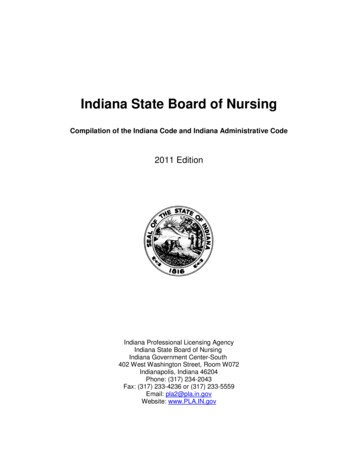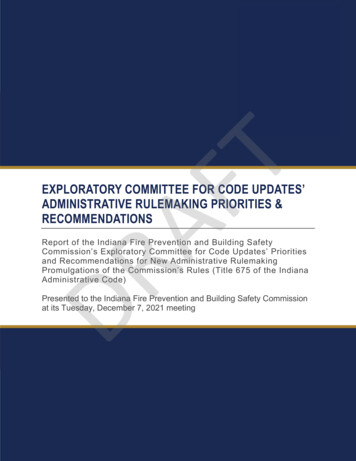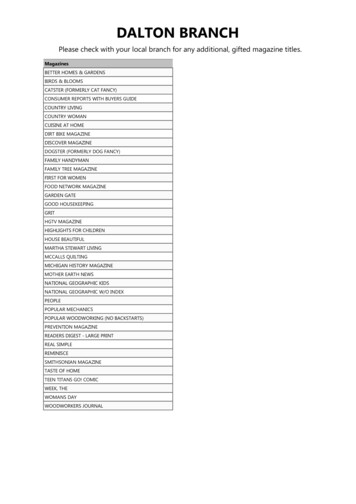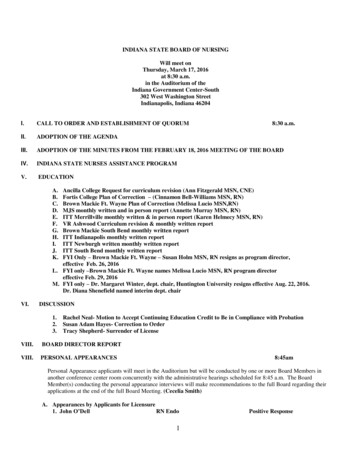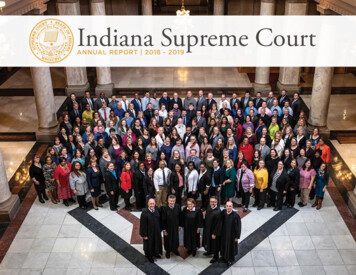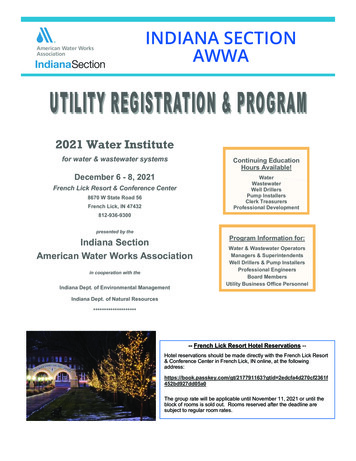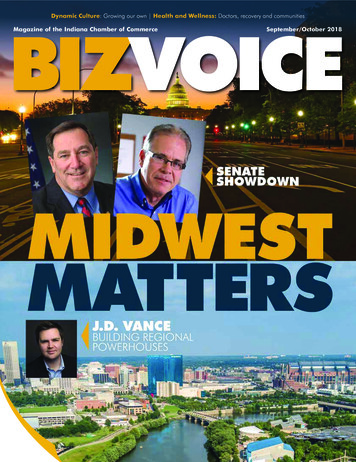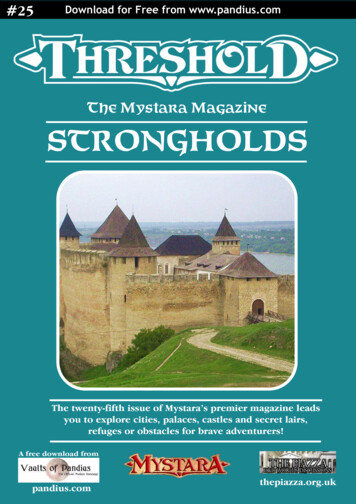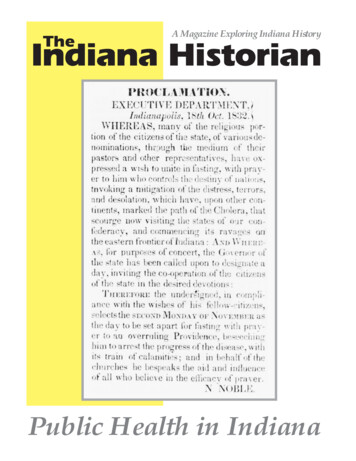
Transcription
TheA Magazine Exploring Indiana HistoryIndiana HistorianPublic Health in Indiana
FocusCover illustration: This proclamation byIndiana Governor Noah Noble (18311837) has been reproduced from theOctober 27, 1832 issue of the IndianapolisIndiana Journal. It illustrates well thebelief that disease was caused by an“overruling Providence.” The proclamationwas first published in the Indiana Journal,October 20, 1832, but the available copywas not clear enough for reproduction.The Indiana HistorianMarch 1998ISSN 1071-3301Order Number 7043EditorPamela J. BennettLead ResearcherPaula A. BongenDesignerDani B. PfaffContributing EditorsCarole M. Allen, Janine Beckley,Alan Conant, Dani B. Pfaff,Virginia TerpeningThe Indiana Historian provides resources and models for the study of localhistory to encourage Indiana’s citizens ofall ages to become engaged with the history of their communities and the state ofIndiana.The Indiana Historian (formerly TheIndiana Junior Historian) is issued quarterly from September through June.It is a membership benefit of the Indiana Junior Historical Society. One complimentary subscription is provided to Indiana libraries, school media centers, andcultural and historical organizations.Annual subscriptions are available for 5.00 plus tax. Back issues are availableat individual and bulk pricing.This material is available to visuallyimpaired patrons in audio format, courtesy of the Indiana History Project of theIndiana Historical Society. Tapes are available through the Talking Books Program ofthe Indiana State Library; contact the Talking Books Program, 317-232-3702.The Indiana Historian is copyrighted.Educators may reproduce items for classuse, but no part of the publication may bereproduced in any way for profit withoutwritten permission of the Indiana Historical Bureau.2The Indiana Historian, March 1998This issue of The IndianaHistorian examines the early yearsof public health science in the latenineteenth and early twentiethcenturies.Below on this page are a fewsuggestions about using this issueas a springboard for furtherinvestigation: “You be the historian.”On pages 3 and 4, there is abrief history of medicine andpublic health issues from a national perspective. The timelinethroughout provides a broadcontext for the topic.Indiana’s efforts and progressin fighting disease and educatingthe public about health are reviewed on pages 5-7. Especiallyimportant was the creation of theIndiana State Board of Health in1881.Dr. John N. Hurty’s leadership of the State Board of Healthfrom 1896 to 1922 is reviewed onpages 8-9. Hurty’s energetic andconfrontational style in the war ondisease is evident in some of thematerials reproduced in thisissue.On pages 10 and 11, the coreproblem of obtaining pure water isaddressed. The drawing on theback cover relates to this topic.Indiana’s fight for healthymilk is briefly reviewed on page12.On page 13, the life andaccomplishments of Dr. HarveyWashington Wiley are reviewed.Wiley was crucial in the passageof the first federal Pure Food andDrugs Act in 1906.The present state of publichealth science is briefly considered on page 14.Page 15 contains the bibliography and sampling of resources.You be the historianThere are many difficult words in thisissue. Have a dictionary on hand tohelp. Explore the public health historyof your area–town or county, for example. Use county histories, newspapers, public records in the courthouse, cemetery records, etc. Createa timeline of that history. Select an important event or person in your public health history andmake a marker–see page 13 of theissue–as a commemoration. Contact public health officials inyour area and the Indiana Department of Health for resources to helpunderstand more about public healthissues today. Dr. John N. Hurty and the StateBoard of Health conducted publicrelations campaigns against healthhazards using posters and otherprinted materials. Survey how suchcampaigns are conducted now; gathersample materials. Identify a currenthealth hazard and produce a campaign to alert others. Investigate the water supply foryour community. Arrange a tour ofthe water treatment facility and/orinvite engineers to make a presentation in your classroom. Explore how your family and yourcommunity make sure your food issafe. Invite a teacher, nutritionist,extension agent, or other food-relatedprofessional to discuss food safety–and other food-related health issues. Explore how milk and other dairyproducts are produced and marketedtoday. Talk to older persons in yourarea. How was milk bottled anddelivered ten, twenty, thirty, or fortyyears ago? What is pasteurization? Is it aprocess only for milk? Invite a physician, health care professional, or scientist to talk withyour class about medical and scientific advances and challenges. Collection of “vital statistics” began in Indiana under Dr. Hurty. Whatare they? How are they collected?Why are they so important? Copyright Indiana Historical Bureau 1998
Progress in public healthLife free from disease is anadvantage that many people in theUnited States take for granted.Most people have confidence thatfood, water, and medicines aresafe, and that waste products andgarbage are disposed of properly.Local, state, and federal laws existto protect citizens from food anddrug adulteration and waterpollution and to require immunization against certain contagiousdiseases. Extraordinary healthchallenges remain, but scientistsnow have sophisticated tools andknowledge to fight diseases andhealth hazards that occur.In the seventeenth, eighteenth, and nineteenth centuries,the situation was very different.Diseases of the earliest colonistsin North America included smallpox, malaria, diarrheas anddysenteries, respiratory problems, measles, mumps, scarletfever, diphtheria, and othersinfectious diseasenon-infectious disease,accident, or violenceLeading Causes of All Deaths for Selected scholerapneumoniapneumoniadysenterytyphoid htheriacroupwhooping coughscarlet feversmallpoxaccidentscarlet fevertyphoid fevertyphoid culatory diseasecanceraccidentspneumonia/influenzamotor rosiasuicidediarrhea/enteritisU.S.statisticsheart omicideThis chart documents causes of death over time. In the later years most leadingcauses of death are no longer from infectious diseases. These statistics demonstratethe effect of advances in science and medicine. Statistics for 1850 and 1991 are forthe United States.Deaths of Children Age Four and under as a Percentage of All Deaths in Indiana1850188239.4% 34.3%19051950199129.3%7.4%1.9%This chart demonstrates the dramatic reduction of early childhood deaths in Indianarelated to all people who died in Indiana (Indiana statistics).391 to 400 BC1000-1009The Canon of MedicineHippocrates, a Greek,written about this time byfounds profession ofAvicenna (Ibn Sina) is a fivephysicians, developsvolume treatment of GreekHippocratic oath, andencourages separation of and Arabic medicine thatdominates the teaching ofmedicine from religion;medicine in Europe until theearns title “Father of17th century (HellemansMedicine” (Hellemansand Bunch, 72).and Bunch, 34). Copyright Indiana Historical Bureau 1998(Duffy, 10). Typhoid, yellow fever,and cholera also killed manypeople.Until the last half of thenineteenth century, doctors knewalmost nothing about the realcauses of diseases. Bleeding,purging, vomiting, and blisteringwere standard treatments for manyillnesses (Ibid., 20). There weremany dangerous patent medicines,including compounds such ascalomel containing mercury whichis poisonous (Janssen, 17).As the population grew beforeand after the American Revolution,the number of people affected withdiseases also increased. Peopleknew that many diseases werecontagious. Doctors did not knowhow diseases were spread. Onepopular theory was the “miasma”theory, which stated that diseasewas caused by the gaseous substances coming from stagnantwater or decaying matter (Duffy,24, 21-22, 41). Doctors and localofficials could find many areas thatfit the “miasma” theory.During the first half of thenineteenth century, street cleaningand garbage removal was theresponsibilty of individual citizens.In addition, hogs, cattle, andhorses were allowed to roam thestreets in cities and towns. Another major problem was thedisposal of human waste. Somelarger cities employed people toempty privies, but most smalltowns had no such provisions.Drainage from overflowing privies12021530171717211763King John of Englandproclaims the firstEnglish food lawprohibiting adulterationof bread withingredients such asground peas or beans(“Milestones,” 1).Paracelsus argues thatmedicine should bebased on nature and itsphysical laws; he is firstto suggest the use ofchemical substances,such as mercury andantimony, as remedies(Hellemans and Bunch, 106).Lady Montagu bringsto England theTurkish practice ofinoculating childrenwith smallpox. Shehas her two childrenvaccinated(Hellemans andBunch, 179).Zabdiel Boylstonintroducesinoculationagainst smallpoxinto Americaduring theBoston epidemic(Hellemans andBunch, 181).First Americanmedicalsociety isfounded inNew London,Connecticut(Hellemansand Bunch,215).The Indiana Historian, March 19983
Progress in public healthcontinuedgenerally considered the firstcomprehensive food adulterationlaw . . . in the United States”(Janssen, 17).American pharmacists andphysicians were also concernedabout the purity of drugs andmedicines. This concern helpedestablish the first two schools ofpharmacy in the U.S.—in Philadelphia in 1820 and in New YorkCity in 1828. By the 1840s, therewas enough concern about drugadulteration that the U.S. Congress passed the Drug Importation Act of 1848. This law required all drugs entering the U.S.through its six major ports to beanalyzed for “quality, purity, andFlu Pandemics: Then and NowYearWhat happenedin 1918What COULDhappen in1998WorldPopulation1.8 billion5.9 billionPrimary mode oftransportationTroop ships,railroadsJetsTime for virus tocircle the globe4 months4 daysPreventivemeasuresGauze masks,disinfectantsVaccinesTreatmentsBed rest,aspirinSomeantiviral drugsEstimated dead20 million60 million?Adapted from Time, February 23, 1998, p. 63.and accumulating garbage oftencontaminated community watersupplies (Ibid., 69, 71, 73, 75).Rapidly growing population,new technology, and increasedmanufacturing in America’s citiesin the nineteenth century broughtadditional health problems. Insmall towns, citizens safely grewand produced most of their ownfood. In larger cities, milk, meat,and canned foods were generallysupplied to people by dairies,meat packers, and food processors. As early as the seventeenthcentury, New York and Massachusetts had laws regulating specificfoods (Young, 33-34). Massachusetts, in 1785, passed what “isThis chart demonstrates how the flu—an infectious disease—spread in1918 and how it COULD spread in 1998. The short time today for adisease to spread globally presents major challenges for public healthscientists. What is a pandemic? What other pandemics havethere been in history? Are there any pandemics today?fitness for medical purposes”(Young, 7, 6, 10, 14).Throughout the rest of thenineteenth century, more statespassed pure food and drug legislation. The Pure Food and DrugsAct of 1906 was the beginning offederal regulation of food anddrugs in the U.S. (Young, 3).During this same period,public health evolved as a medicaldiscipline and a governmentalfunction. Reviewing public healthin Indiana in 1916, Dr. William F.King, assistant state healthcommissioner, provided hisdefinition of the field of publichealth:Public health is synonymous withpreventive medicine, and preventivemedicine had its real beginning withthe discoveries of Pasteur . . . .Pasteur proved that so-calledcontagious diseases were due togerms . . . and he said, “It is within thepower of man to drive all contagiousand infectious diseases from the earth”(King, 272).The life expectancy of a maleinfant at birth in Massachusettsor New Hampshire in 1789—just afew years after the AmericanRevolution—was 34.5 years(Cummings, [238]). The life expectancy of a white male born in1990 was 72.9 years (StatisticalAbstracts of the U.S.). The dramatic increase in life expectancycan be traced to the efforts ofscientists in private businessesand government agencies toprotect and improve the publichealth of American citizens (Duffy,134, 148-49).17651785178917931795179618001808John Morganfounds firstmedical schoolin America atthe College ofPennsylvania(Hellemans andBunch, 217).Massachussettsenacts firstgeneral foodadulteration lawin the UnitedStates (“Milestones,” 1).Life expectancy of maleinfants at birthin Massachusetts and NewHampshire is34.5 years(Cummings,[238]).An epidemic ofyellow fever inPhiladelphiakills about10% of thepopulation(Hellemansand Bunch,243).Napoleon offers prize forpractical method of foodpreservation. Francois Apperteventually receives prize byintroducing process of bottlingor canning, heating, and thensealing (Hellemans andBunch, 245).English physicianEdward Jennerperforms firstinoculationagainst smallpoxby infecting a boywith cowpox(Hellemans andBunch, 245).BenjaminWaterhouse isfirst U.S.physician to usenew smallpoxvaccine—on hisson (Hellemansand Bunch, 251).August 204The Indiana Historian, March 1998Vincennes Western Sun,August 20, 1808, statesthe cause of diseasesaffecting town are to befound in the decayinggrasses growing alongthe river. Copyright Indiana Historical Bureau 1998
Health of HoosiersEarly settlers in Indianaendured the hardships of establishing homes, towns, and farmsin the wilderness. In addition,these settlers faced seasonalfevers, frequent epidemics, andmany other devastating illnesses.People did not know whatcaused these terrible diseases.Doctors, with little or no training,treated patients using primitivemethods and unregulated medicines, and hoped for the best. Afew people believed that stepscould be taken to help improve thehealth of the public. One suchperson was Elihu Stout, editor ofthe Vincennes Western Sun, whoseeditorial from 1808 is reproducedon this page.By the 1830s, some Indianatowns had established boards ofhealth (Thornbrough, 668). Townofficials also enacted laws regulating sanitation and providing forquarantine. The success of theseattempts was limited. “Disease wasstill pretty much considered to bea result of sin, and pestilence wasusually regarded as a dispensationof Providence” (Rice, 48). Theproclamation, on the cover of thisIn 1832, Dr. DanielDrake of Cincinnati,Ohio explained howpeople could helpthemselves survivethe cholera epidemic(excerpted from theMadison IndianaRepublican, October18, 1832). Drakewas a well-knownphysician of theperiod.[. . .][. . .][. . . .][. . .][. . .][. . . .][. . . . . . . . . . . . . . . . . . . . . . ]Elihu Stout, editor of the Vincennes Western Sun, used his newspaperon August 20, 1808 to encourage people to help improve healthconditions. He warned against the dangers of decaying grasses by theWabash River, the source for drinking water. He also advocatedcleaning up the town’s streets, especially removing carcasses of deadanimals which were allowed to rot where they lay. Note the use of an“f” for an “s” in many words; it is an early writing néLaënnec ofFranceinvents thestethoscope(Hellemansand Bunch,265).Pandemic ofcholeraspreads overIndia, EastAfrica, andAsia(Hellemansand Bunch,265).October 18Oliver Wendell Holmes ofMassachusetts advisesdoctors to prevent childbedfever (puerperal fever—common to mothers afterchildbirth at the time) bywashing their hands andwearing clean clothes(Hellemans and Bunch, 311).The Commission forEnquiring into Stateof Large Townsestablishes aconnection betweendirt and epidemicdisease in England(Hellemans andBunch, 311).AmericanMedicalAssociation isfounded(Hellemansand Bunch,315).IndianaMedicalSociety isfounded inIndianapolis(Russo, 40).4.5% of Indiana’spopulation lives intowns of more than2,500; by 1880 thisnumber had risen to19.5% of Indiana’spopulation(Thornbrough, 555).Cholera epidemicprevails throughoutIndiana. Governor Nobleproclaims secondMonday in November asday of fasting and prayer(Indianapolis IndianaJournal, October 27, 1832). Copyright Indiana Historical Bureau 1998The Indiana Historian, March 19985
Indianapolis Star, November 24, 1918.issue, by Governor Noah Nobleabout the 1832 cholera epidemicprovides a good example of thatwidespread belief.The cholera epidemics in1832 and 1849 encouraged attempts by Indiana physicians toorganize crusades against diseases. In June 1849 in Indianapolis, the Indiana State MedicalSociety was created. It noted thattreatment of disease was important, but it promoted the relativelynew idea that prevention of disease was vital. In its first years,the society requested the IndianaGeneral Assembly to pass a lawrequiring registration of births,marriages, and deaths so thatdata could be collected to help indisease prevention. In 1851, asociety committee lobbied theGeneral Assembly to enact legislation requiring drug manufacturersto reveal the exact ingredients oftheir compounds (Russo, 40-41).It took decades to accomplishthese valuable measures.In 1852, the General Assembly did pass legislation giving citygovernments authority to establish boards of health and toprevent pollution of streams withsewage, rubbish, and dead animals. Cities could “destroy putridanimal or vegetable matter” andcompel building owners to cleanup dirty buildings. Cities were alsoauthorized to establish quarantineregulations. However, sanitaryand public health regulationsIndianapolis Star, October 11, 1918.continuedIndianapolis Star, October 7, 1918.Health of HoosiersThese excerpts from the Indianapolis Star illustrate the effect of the 1918 worldwide flupandemic in Indiana. How did this pandemic affect your community? Are there seniorcitizens who remember it, and can you talk with them about their memories?seem generally to have beenignored (Thornbrough, 571).Luther D. Waterman, M.D.,president of the Indiana StateMedical Society, chastised theGeneral Assembly and encouragedhis fellow doctors in his 1878address:We must not cease our labors, as abody, until the citizens of this Statehave pure air to breathe, pure water todrink, unadulterated food andmedicines, live in buildings that are notsources of infection to themselves ortheir neighbors, and have an intelligentbody of agents to warn and protectthem from preventable, indigenous,and importable causes of disease(ISMS, Transactions, 1878, p. 3).In the 1870s, the IndianaState Medical Society began topromote the idea of a state boardof health. Finally, the GeneralAssembly passed legislation onMarch 7, 1881 creating the Indiana State Board of Health. Fivethousand dollars per annum wasappropriated for the work of theboard for two years (Rice, 56, 61).The early years of the IndianaState Board of Health were notvery productive because of lack offunds and changes of personnel(Ibid., 61-64). It worked to establish local boards of health incounties, cities, and towns of thestate. It devoted much time toorganizing a system of registrationof vital statistics. It tried to educate physicians and local sses apure foodand drinklaw(“Milestones,” 1).A city ordinancegives theIndianapolisBoard of Healthbroad powersover vaccinationagainst smallpox(Thornbrough,572-73).Englishman, JohnSnow, shows thatprohibiting use of wellcontaminated withsewage reducesincidence of cholera inthe vicinity of the well(Hellemans andBunch, 325).Massachusetts lawprohibitsadulteration of milk,and three yearslater prohibits thefeeding of distillerywaste to cows(Cummings, 55).Englandenacts aFood andDrugs Act(Grun, 425).President Lincolnappoints a chemist toserve in the newDepartment ofAgriculture—thebeginnings of theBureau of Chemistry(“Milestones,” 1).Joseph Lister ofEngland introducesphenol as adisinfectant insurgery, reducingsurgical death ratefrom 45% to 15%(Hellemans andBunch, 337).January 166The Indiana Historian, March 1998A patent for arefrigerator car isgranted to WilliamDavis, Detroit, Michigan.Davis also designs firstrefrigerated railroad carwhich is built 1869(Carruth, 299). Copyright Indiana Historical Bureau 1998
One campaign of the IndianaState Board of Health under Dr.John N. Hurty focused on thecare and health of newbornbabies. The board distributedThe Indiana Mothers’ BabyBook, pictured in this poster.“The book was reprinted for anumber of years and literallythousands of copies weredistributed.” The poster wasoriginally printed in the ISBHBulletin, October 1915 (Rice,310, 312).Dr. John N. Hurty had a veryconfrontational style in his waron disease. According to Rice(253), this is “A typical HurtyPoster of this Period [circa1911-1915] Grim, Morbid andTerrifying.” Look at health andmedical advertisements today.How do they comparewith Hurty’s?officers about the causes andcontrols of diseases (ISBH,Monthly Bulletin, 35:11 [November1932], 163, 164). Many Indianaphysicians and citizens did not yetbelieve in the germ theory ofdisease (Phillips, 470).In 1896, John N. Hurty, M.D.was elected secretary of the Indiana State Board of Health, aposition he held until 1922. Underhis leadership, the effectiveness ofthe Indiana board was rankedsixth in the nation in an AmericanMedical Association study in1914-1915 (Madison, 309).According to Madison, “Bythe 1920s, the professional physi-18741878Illinoispasses firstgeneralstate foodlaw(Cummings,97).President of theIndiana State MedicalSociety emphasizescontaminated water,adulterated food, and“air impregnated withnoxious gases” ascauses of disease(Thornbrough, 668-69). Copyright Indiana Historical Bureau 1998cian had achieved wide, though notcomplete, acceptance as the primary source of medical care” (308).By that time also, the State Boardof Health had made advances incontrolling “diseases transmittedby impure water, milk, and food”(309). But the work of the board—and others—was needed, especiallyin the area of impure water:Lakes, rivers, and streams were grosslypolluted by domestic waste and byindustrial wastes from canneries, oilrefineries, meat-packing plants, andfactories. Perhaps the most obviouslyoffensive sources of pollution were themany city and town sewer systemswhich simply discharged raw wastedirectly into the closest river (310).187818801880188118811882Survey of Indianaphysicians shows thatthere is generalacceptance amongthem that typhoid,malarial fever andcholera are caused bygerms (Thornbrough,667-68).LouisPasteurdevelops thegerm theoryof disease(Hellemansand Bunch,355).By this time all majorIndiana cities havesome sort of sewers,mainly to carry off rain.No more than 10% ofprivate houses inIndiana have indoorplumbing (Thornbrough,572).IndianaGeneralAssemblyvotes toestablish aState Board ofHealth(Thornbrough,668).New York,New Jersey,and severalother statespass purefood laws(Cummings,97).Robert Kochdiscovers bacteriumthat causestuberculosis, the firstdefinite associationof a germ with aspecific humandisease (Hellemansand Bunch, 359).The Indiana Historian, March 19987
Rice, 69.Hurty leads the fightDr. John N. Hurty in 1896.This cartoon honors Dr. Hurty’s service toIndiana. It expresses the positive effectthat Hurty’s bill in the Indiana GeneralAssembly could have for Indiana. Hurtyhad resigned from the State Board ofHealth and been elected to the GeneralAssembly in 1922. The cartoon appearedin the Indianapolis Times, January 11,1923. The bill was defeated in February(Rice, 376).8Dr. John N. Hurty was appointed head of the Indiana StateBoard of Health in 1896. Onehistory of public health inAmerica, cites Hurty as one of six“civic health leaders who influenced health reform at the stateand national levels” (Duffy, 222).John Newell Hurty was bornon February 21, 1852 in Lebanon,Ohio. When he was fourteen, hisfamily moved to Paris, Illinois.Here he met Colonel Eli Lilly.Hurty later recalled, “Col. Eli Lillybeguiled me into the drug business. . . . shaped my life work”(Rice, 10).Lilly was part owner of theBinford and Lilly Red Front Drugstore. From 1869 to 1871, Hurtywas Lilly’s apprentice. Encouragedby Lilly, Hurty attended thePhiladelphia College of Pharmacyand Science for one year, returning in 1872 (Ibid., 17, 18-19).In 1873, Lilly left Paris forIndianapolis, where he opened apharmaceutical laboratory withDr. John Johnstone, a dentist. AtLilly’s request, Hurty joined themas their chief chemist. In 1879,Lilly and Johnstone ceased theirpartnership. Lilly went on tofound Eli Lilly and Company, theIndianapolis pharmaceuticalcorporation (Ibid., 19).In 1879, Hurty opened hisown drugstore at the corner ofOhio and Pennsylvania streets. Inthe basement, he set up one of thefirst analytical laboratories in thestate. He tested the purity ofwines for local hotels, paints andlubricants for the railroads, coalfor the power company, and waterfor the Indianapolis Water Company. He also created cosmeticsfor local theatre troops (Ibid., 1920, 30-31).Over the next ten years,Hurty began his long associationas a faculty member with both theIndiana Dental College and theMedical College of Indiana. In1884, he established, and for atime taught at, the School ofPharmacy at Purdue University. In1891, Hurty earned his medicaldegree from the Medical College ofIndiana (Ibid., 38-39, 25, 36).Hurty fought for andachieved many advances in thetwenty-six years he led the StateBoard of Health. The chart of lawspassed on the next page showsthe broad range of daily life andbusiness that was connected tothe public health of citizens.In 1922, he resigned to runfor the Indiana General Assembly.He was elected in 1922. His majorgoal was passage of legislation tostrengthen the State Board ofHealth. His efforts were defeated,(Ibid., 370, 373-376). He died onMarch 27, 1925.Sources: See Justin E. Walsh, gen.ed., A Biographical Directory of theIndiana General Assembly, Vol. 2,1900-1984 (Indianapolis, 1984), 209210, for specific biographical information.1883188318891890189618981899Robert Kochdiscovers bacteriumthat causes choleraand shows thatcholera can betransmitted by foodand drinking water(Hellemans andBunch, 361).Dr. Harvey W.Wiley of Indianabecomes chiefchemist of theU.S. Departmentof Agriculture(“Milestones,” 2).Indiana StateBoard of Healthofficially endorsesgerm theory in itspublished report(Phillips, 470).Life expectancyof white males atbirth in the U.S.is 42.5 years(StatisticalAbstracts of theU.S.).March 5June 2Dr. John N. Hurty iselected to thesecretaryship of theIndiana State Boardof Health (Russo, 44).Paul-Louis Simond, fightingthe bubonic plague pandemicin Bombay, India, realizesthat fleas on rats transmit thedisease to humans(Hellemans and Bunch, 391).Indiana GeneralAssemblypassescomprehensivefood and druglegislation(Phillips, 471).The Indiana Historian, March 1998 Copyright Indiana Historical Bureau 1998
Guard against fliesSome achievements in Indianaunder Hurty’s administrationat the State Board of HealthPure Food and Drug Law1903 -Quarantine Law1907 -Sterilization Law-Anti-toxin Law-Drug Sample Law-Pure Food and Drug Law,amended in 19111909 -Sanitation of Food ProducingEstablishments Law1911 -Prevention of InfantBlindness Law-Hydrophobia Law-Renovated Butter Law-Cold Storage Law1913 -Vital Statistics Law-Sanitary Schoolhouse Law-Medical School Inspection Law-Anti-Rat Law-Public Water Supply Law-Weights and Measures Law-Clean Milk Can Law-Public Playgrounds Law-Establishment of SanitaryDistricts-Housing Law-County Hospital Law-Sanitary Mattress Law-Fertilizer Reduction Plant Law-Mausoleum Law-False Advertisement Law-Cigarette Law-Transportation of SchoolPupils Law-Schoolhouse Civic andRecreation Center Law-Child Neglect Law, amendedin 19151915 -C.A.Indianapolis Star, September 5, 1909.1899 -The danger of flies—as carriers of “filth-borne diseases” such as typhoid fever—wasa major campaign of the Indiana State Board of Health under Dr. John N. Hurty. A:This health poster “in true Hurty style” shows and tells the dangers of flies (Rice,140). B: This vivid image was on a State Board of Health postcard with a messageabout filth to “Dear Citizen” from “A Housefly and Family” (Rice, 143). C: Thenewspaper clipping gives some indication of statewide inaction in 1909.B.Anti-Tuberculosis Law-Full Sized Sheet Law-Drainage, Sanitary andReclaiming District Law-Sanitary Packing and Shippingof Rags and Paper Stock Law-Cutting Weeds Along PublicHighways LawSource: J. N. Hurty, “Review of Public Health Work inIndiana,” in Lee F. Bennett, ed., Proceedings of the IndianaAcademy of Science 1916 (Indianapolis, 1917), 233-35.1902190219061907191219181920U.S. Congressappropriates funds toestablish foodstandards and to studythe effects ofchemicals on digestionand health (“Milestones,” 2).Congress passeslaw organizing U.S.Public Health andMarine HospitalService thusestablishing for thefirst time a federalrole in public health(Duffy, 240-41).June 30Indiana GeneralAssembly revises itsfood and druglegislation, alignedmore closely withfederal Pure Food andDrugs Act (OutdoorIndiana, September1970, 33).Dr. John Hurty,Indiana StateBoard of Health,is electedpresident of theAmerican PublicHealth Association (Russo, 46).October 10Life expectancyof white malesat birth in theU.S. is 56.34years; all othermales, 47.14(StatisticalAbstracts of theU.S.). Copyright Indiana Historical Bureau 1998Pure Food and DrugsAct is passed byCongress; on same day,Meat Inspection Actpasses requiring federalinspection for all plantsin interstate commerce
able through the Talking Books Program of the Indiana State Library; contact the Talk-ing Books Program, 317-232-3702. The Indiana Historian is copyrighted. Educators may reproduce items for class use, but no part of the publication may be reproduced in any way for profit without written permission of the Indiana Histori-cal Bureau.
